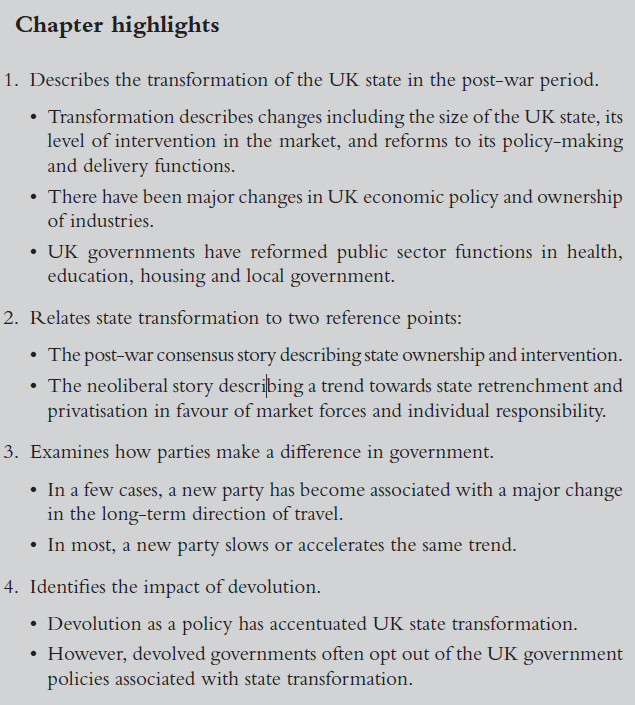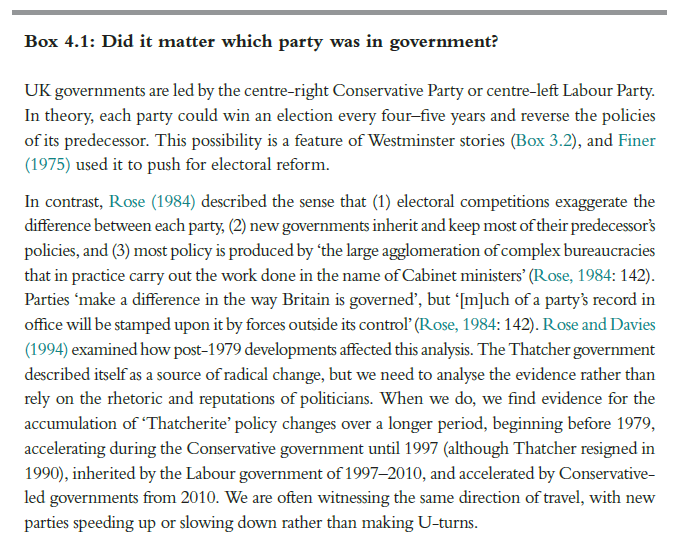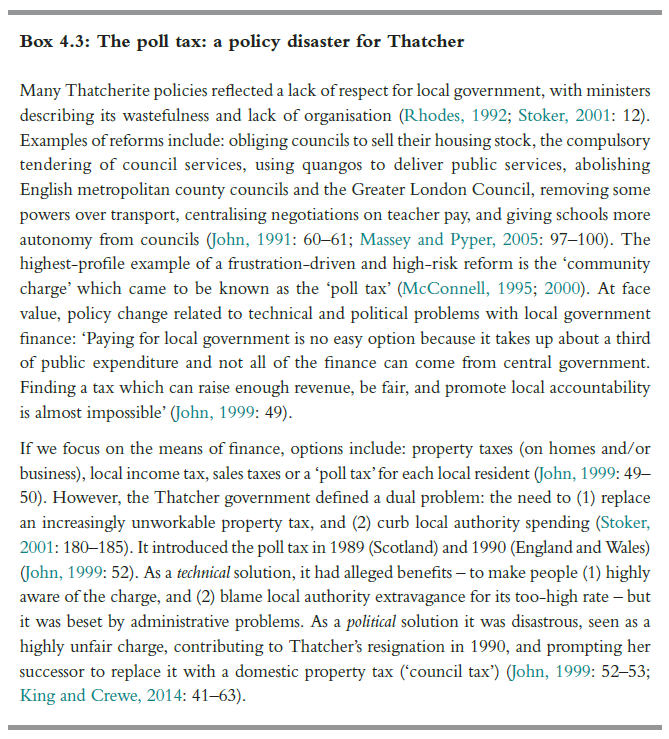This post introduces chapter 4 of Politics and Policy Making in the UK by Paul Cairney and Sean Kippin.

What do we mean by state transformation?
State transformation describes a collection of major changes to policy and policymaking from the ‘post-war settlement’ towards ‘neoliberal reforms’ (towards a smaller state and less state intervention). There were many ‘neoliberal’ reforms to UK policy, policymaking, and delivery functions from the election of a Thatcher-led Conservative government from 1979. However, we are not really describing a coherent and wholesale shift from one model of state intervention to another. Further, the election of a different party did not necessarily prompt a wholesale shift of approach.

What was the post-war consensus?
Consensus describes the maintenance of a similar approach to policy and policymaking throughout multiple changes of Labour and Conservative government (from 1945). This approach is characterised by higher state intervention to address policy problems. It includes:
- A Keynesian approach to economic policy (high state intervention via fiscal policies).
- An expanded welfare state, withnew entitlements to social security (including pension, unemployment and child benefits), access to free public services such as healthcare and education, and subsidized social housing.
- A large industrial state, with high state ownership of industry and public utilities.
- The funding and direct delivery of public services.
What were neoliberal reforms?
Neoliberal can mean the preference for: individual rather than state responsibility (e.g. for improving your health), market rather than state action (e.g. to promote economic growth), and economic growth as the primary aim. As such, reforms would include:
- The rejection of Keynesian intervention, based on belief that state intervention harms market forces, in favour of controlling inflation via monetary measures.
- Reduced policy commitments in relation to full employment and the welfare state, and being prepared to trade higher unemployment for low inflation. For example, the idea may be to seek a ‘natural rate of unemployment’, or the lowest level of unemployment that does not cause excessive inflation via inflationary wage demands, exacerbated by the negotiating power of trade unions, and too- high unemployment benefits.
- The privatisation of industry and reform of public services.
Economic Policy: From Keynesianism To Neoliberalism?
Chapter 4 describes a series of broad phases of activity, including:
1940s and 1950s: UK government policy changes consistent with Keynesian thought. For example, high taxation and spending to manage demand and seek full employment.
1960s: making state intervention work by modifying a Keynesian approach. For example, defending a Keynesian approach but modifying action to address unexpected problems (e.g. lower than expected growth, and a currency crisis)
1970s: a series of crises. They included the Conservative government (1970-74) seeking in vain to ‘roll back the state’, then a Labour government (1974–1979) facing rising inflation and unemployment, and a reduction in the value of sterling. The government’s need to borrow heavily, to finance major spending deficits, prompted initial attempts to reduce public expenditure.
1979–1997: a rejection of Keynesianism? Peter Hall describes a ‘paradigm change’ from Keynesianism to monetarism in the early 1980s, while Oliver and Pemberton describe longer term change towards neoliberal approaches.
1997 onwards: a mix of ‘neoliberal’ aims and new Keynesian’ policies. The New Labour government (1997-2010) sought to project an image of economic competence based on fiscal prudence (keeping government debt to 40% of GDP), granting independence to the Bank of England, and minimizing regulation of ‘the City’ (financial institutions).
Then came the global financial crisis, high state intervention, then ‘austerity’ (Chapter 9). Overall, we describe from 1979 an often-confusing mix of low-state intentions and unwanted high state action during crisis.
The story of employment policy is less confusing: from 1980 there has been a succession of Employment Acts to restrict the power of trades unions, based initially on Thatcher government antipathy to unions and consultation with interest groups (chapter 5), but maintained under Labour and accelerated by Conservative governments. The ability of trades unions to organize and call strike action has been reduced profoundly.
Privatisation and new public management
There has been a profound shift from a UK industrial state. For example, in 1950, the nationalized industries – water, coal, electricity, steel, gas, oil, rail, telecommunications and postal delivery – employed 2.3 million people. In 1980 they employed 1.8 million. By 1997: 0.24 million. UK governments sold £74 billion of state assets from 1979-1997 and £8 billion since then (2020 prices).
Thatcher governments also encouraged the mass sale of social housing. The 1980 Housing Act introduced a renter’s ‘right to buy’ their council house (and a discount based on years of renting). From 1980-2003, 2.8 million homes were sold. To some extent, this obligation for councils was part of a wider challenge to local authorities, which included the ill-fated poll tax.

Privatisation also extended to:
- deregulating services (e.g. buses)
- obliging the private delivery of public services (e.g. making public bodies like councils ‘contract out’ some services)
- using private investment for capital projects (e.g. to fund investment in roads, bridges, hospitals, schools)
- reducing subsidies or increasing charges for services (e.g. for prescriptions, opticians, higher education tuition).
New public management reforms involve the application of private sector ideas or methods to the public sector. Examples include:
- NHS reforms to introduce an ‘internal market’
- Education (schools) reforms in England to foster ‘school choice’, shift from comprehensive schooling, and shift from local authority control.
- Civil service reforms, to reduce their number, recruit from outside, and separate policy and delivery (in Executive Agencies). Governments have also sought to establish new policy advisory systems (with more involvement from consultancy and think tanks)
Measures of state retrenchment or transformation
It is not always straightforward to demonstrate state transformation. For example, state spending as a proportion of GDP was 45% in 1988, which was lower than 1982 (54%) but higher than the mid-1950s (then it rose heavily under New Labour before ‘austerity’ from 2010 – Chapter 9). Still, the industrial state has vanished, and the role of the state in public service delivery has transformed (see Chapter 4 for examples). ‘Neoliberal’ also extends to a reluctance to foster ‘nanny state’ intervention.
The impact of devolution on state intervention
One the one hand, political devolution in 1999 represents the further transformation of the state towards multi-level policymaking. On the other hand, devolved governments are usually less keen on neoliberal reforms (although it is difficult to present a complete picture in Northern Ireland, since its Assembly was suspended in 2000, 2002–2007 and 2017–2020, and in flux from 2022-4). Examples include:
- Healthcare. The Scottish and Welsh governments sought to remove or slow UK reforms. All 3 governments phased out prescription charges.
- Schools. The Scottish and Welsh governments prefer comprehensive schooling. All 3 are less keen than the UK on ‘league tables’ of school performance.
- Local government. The Scottish and Welsh governments foster better central-local relations, and more trust in public bodies to deliver services.
Overall, there has been a transformation of the UK state
It moved from a ‘postwar consensus’, built on the belief that governments could and should intervene to benefit the UK population by delivering employment, education, healthcare, housing and social security. It moved towards ‘neoliberalism’, built on the belief that state intervention undermines the market and that individuals should take responsibility for their welfare. The size of the industrial state fell dramatically. The UK government is less committed to the ‘old’ Keynesian measures to tax and spend to manage demand in the economy. Tax- funded public services remain, but the state is much less likely to deliver them directly. Multiple reforms have changed how the civil service and policy advisory systems operate.
Parties made a difference to this transformation. Labour introduced the policies associated with the post- war consensus, and the Conservatives pursued a commitment to neoliberalism. However, parties also inherited the commitments of their predecessors, accepting or accelerating policies of the past. Most elements of state transformation are here to stay, regardless of party.
See also Chapter 5 on how we can describe and explain the transformation.








Pingback: Chapter 5. What Does State Transformation Tell Us about the UK Policy Process? | Paul Cairney: Politics & Public Policy
Pingback: Chapter 9 Economic Policy: Austerity | Paul Cairney: Politics & Public Policy